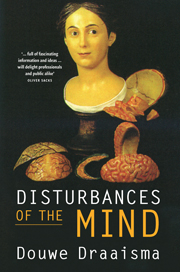Book contents
- Frontmatter
- Contents
- Introduction
- 1 Towards dusk the images appear
- 2 A tormenting round of tremors
- 3 Phineas Gage’s posthumous stroll
- 4 The Celestine prophesy
- 5 Sparks from a Leyden jar
- 6 Siberian brandy
- 7 Go to hell, idiot! Gilles de la Tourette syndrome
- 8 A labyrinth of tangles
- 9 The Mercator of neurology
- 10 The headquarters of madness
- 11 A cup of tea for the doppelgänger
- 12 Little professors
- 13 The Cardan suspension of science
- Index
- References
3 - Phineas Gage’s posthumous stroll
the Gage matrix
Published online by Cambridge University Press: 05 March 2014
- Frontmatter
- Contents
- Introduction
- 1 Towards dusk the images appear
- 2 A tormenting round of tremors
- 3 Phineas Gage’s posthumous stroll
- 4 The Celestine prophesy
- 5 Sparks from a Leyden jar
- 6 Siberian brandy
- 7 Go to hell, idiot! Gilles de la Tourette syndrome
- 8 A labyrinth of tangles
- 9 The Mercator of neurology
- 10 The headquarters of madness
- 11 A cup of tea for the doppelgänger
- 12 Little professors
- 13 The Cardan suspension of science
- Index
- References
Summary
In the early 1970s, a most intriguing patient walked into the surgery of the neurologist Antonio Damasio. The man (Damasio refers to him as ‘Elliot’) was in his early thirties and had developed a fast-growing tumour in the cerebral membranes, just above the nasal cavity. The growth was pressing upwards against the two frontal lobes and had to be removed. The tumour proved benign and, medically speaking, Elliot’s prospects were excellent. But after the operation his personal life began to fall apart. He was employed by a commercial firm, and when he returned to his job, he found that he had difficulty coordinating his tasks. He had lost all sense of priority. He ignored repeated warnings and offers of advice from his colleagues, and in the end he was fired. He threw himself into various business ventures and, after a foolhardy investment, was declared bankrupt. His marriage ended in divorce, as did a remarriage entered into shortly afterwards. Within a few short years he was down and out and his personal life was in ruins. Having been refused benefits, on the grounds that he was physically healthy and his mental faculties appeared to be intact, he found his way to Damasio’s surgery. He hoped that the doctor would be able to establish that his condition was caused by a neurological disorder, entitling him to a disability allowance.
Brain scans showed that during the operation, the front of both frontal lobes had been damaged, the right side the most severely. However, much was still intact, including the frontal cerebral cortex, which is involved in language, memory and muscular coordination. The same pattern was seen in the neuropsychological tests which Damasio carried out on his patient. The man’s intellectual powers were not affected: he scored well above normal on an IQ test. But Damasio did notice that when Elliot described the turn his life had taken, he recounted the events as if they had not happened to him, but to some third person. Divorce, bankruptcy, the loss of his job – he spoke of these things dispassionately, as if he were discussing a random acquaintance. After a test in which he was confronted with emotionally charged stimuli, such as images of people drowning or houses on fire, Elliot acknowledged that events which previously would have moved him no longer evoked any emotion.
- Type
- Chapter
- Information
- Disturbances of the Mind , pp. 65 - 96Publisher: Cambridge University PressPrint publication year: 2009
References
- 1
- Cited by



